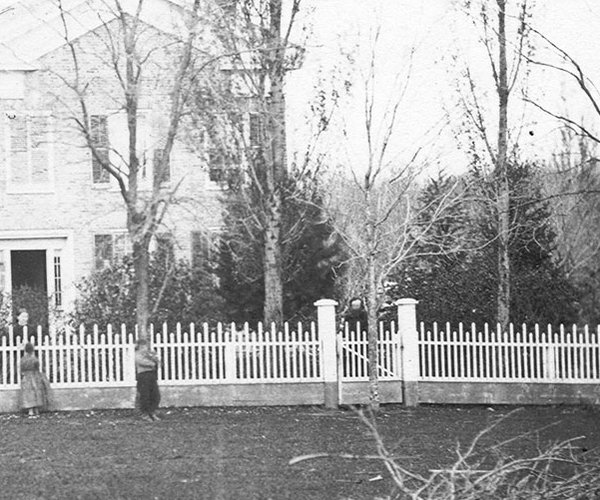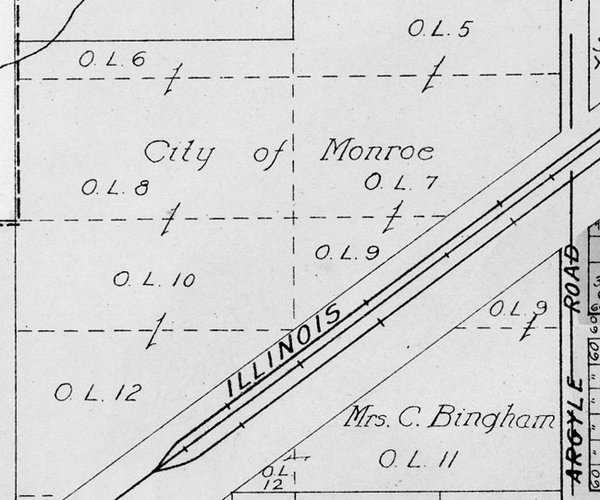The people of Monroe appreciated what retired farmer Peter Wells had been doing for the community since he moved to Monroe sometime in the 1860s. It was shared on January 5, 1876 that “an idea was cogitated in the fertile brains of a few individuals to get up a surprise party and give our fellow citizen a New Year’s call.” An address was drawn up and signed by about 300 persons. “It extolled the many virtues of Peter, and expressed the esteem of his fellow citizens for his many enterprises in building up the waste places of the town, and his public spiritedness, and particularly his last determination to go into active business.”
The crowd assembled and formed a procession on the east side of the Square and proceeded to Wells’ restaurant. A. S. Douglas, escorted by O. H. P. Clarno with a lighted lantern, carried the petition and address, which he read to Wells. “The address wound up with a petition to treat the crowd to oysters. It was a good sized crowd, and Uncle Peter so regarded it. At least we surmised as much. It was unfortunate that the oysters were out entirely. Other and more profitable customers had been in through the day. The cigars were set up by Peter, the Great man of the occasion, and so the affair ended in smoke, much to the satisfaction of all concerned.”
An advertisement for Wells & Son’s “new grocery and confectionery store” appeared on March 1, 1876. It was located on the east side of the Square, at the old stand of P. S. Kahly, who was still in charge of the restaurant department and was one of the best caterers in the business. Oysters were served by the dish in any style on short notice. They also carried “a large stock of pure candies, a complete line of toys, notions, and knicknax.” They also advertised “sugars, sirups, soap, teas, vinegar, saleratus, coffees, carbon oil, starch, pickles, pipes, tobacco, cigars, canned goods, patent groceries, dried fruits, nuts, spices,” and much more. Fresh molasses and cream candy were made daily. They also advertised that they had “the highest price paid for butter, eggs, lard, cheese, etc.”
One Sunday afternoon in April, the cornice and face supports in front of Peter Wells & Son’s store fell to the ground. Fortunately, nobody was passing by at the time. The damage was estimated to be $100.
The “ice cream season” opened in mid-May with Peter Wells & Son “giving the printers a cordial invitation.” Kahly was again making the ice cream. It was also reported that they had “just received a full stock of groceries and [he] keeps the best grades of flour, buckwheat, cornmeal, &c. Fresh oysters on hand by the dish.”


Wells continued to stay busy in 1877. He talked in January of building additional store rooms on his lots adjoining the Sentinel office building in the spring, but nothing more was ever mentioned of that. In December, it was announced that J. A. Barling had rented a store of Peter’s on the north side of the Square that had previously been rented by the “transient clothing firm.” That store was re-fitted and put into good condition. This enabled Barling to “keep a larger and better stock of clothing, boots, shoes, hats, caps, and underwear.”
It was shared on February 13, 1878 that Peter, 67, who had been “quite sick since his recent trip to Iowa, in which he caught a dreadful cold, is out and about again, a little the worse for wear, it is true, — but well enough to collect rents.” The following week, Peter had an advertisement in the newspaper that he had a number of dwelling houses, and one good store room, for sale or rent.
It was announced again in March 1879 that Peter was talking of building his new block east of the Sentinel Office that summer. But Peter lost one of his buildings in the large fire that destroyed the south half of the east side of the Square on May 22, 1879. This was probably the same building that housed the Wells & Son store, which was quickly rebuilt. Much information about this fire was shared in previous columns in October 2022.
It was shared on June 11 that Jacob Steinman had the contract to build the two-story block east of the Sentinel Office, which would be 30 feet high and 100 feet deep of brick with iron cornices. Steinman was also contracted to build other buildings that had been destroyed in the fire on the east side of the Square. These buildings were already up to the second story early in July and were expected to be under roof by the end of the month.
It was shared on September 3 that Peter had the contract to repaint and improve the Sentinel building, which was to include having “it tucked similar to the front on the east side.” At that time he thought that he wouldn’t build next door “before next spring - though he may build this fall.”
When the Sentinel announced on February 25, 1880 that Wells was talking of building “that new block next spring,” the editor added, “Come along, Peter, we have got another months pay for you.” By late in February, it was announced that he had the sand and timber and would soon have the lime and brick for the new block. It would be 80 feet on the front and two stories high. The editor added, “Mack & McCracken want the most of the building for their agricultural implement business, and we want a room up-stairs.”
If you read the next five columns, you’ll find out more about the property that Peter Wells owned, the buildings that he built or purchased, and the fires that damaged his property.
— Matt Figi is a Monroe resident and a local historian. His column will appear periodically on Saturdays in the Times. He can be reached at mfigi48@tds.net or at 608-325-6503.





